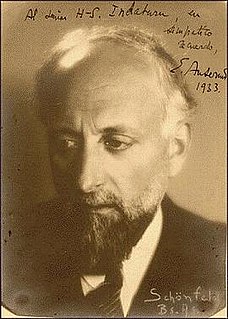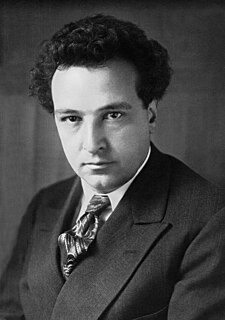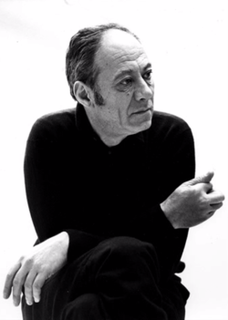The Orchestra Symphonique de Paris (Symphonic Orchestra of Paris) was an orchestra principally active in Paris from 1928 to 1939. The orchestra was co-founded by Ernest Ansermet, Louis Fourestier and Alfred Cortot and gave its first concert on 19 October 1928 at the Théâtre des Champs-Élysées. [1]

Ernest Alexandre Ansermet was a Swiss conductor.
Louis Fourestier was a French conductor, composer and pedagogue, and was one of the founders of the Orchestre Symphonique de Paris.

Alfred Denis Cortot was a Franco-Swiss pianist, conductor, and teacher who was one of the most renowned classical musicians of the 20th century. He was especially valued for his poetic insight into Romantic piano works, particularly those of Chopin, Saint-Saëns and Schumann.
The financial support for the orchestra came from wealthy sponsors such as Gustave Lyon, director of Pleyel, two banker Ménard brothers, and the Princess de Polignac. [1] Members of the management board were Robert Lyon (general administrator), Charles Kiesgen (administrative secretary), André Schaeffner (artistic secretary) along with Henri Monnet and Jean Gehret. Financial difficulties forced the orchestra to become an association in mid 1931. [2]
The aim of the new orchestra was to present less-known works of major composers as well as contemporary music and the central concert repertoire, playing to a high standard. [3] The standard of the orchestra was considered to be high, partly due to the number of rehearsals before each concert. [1] [4] Of the eighty musicians chosen (out of 600 auditioned) the majority were under 25. [2]
From 1929 Pierre Monteux was invited by Cortot to become closely involved with the orchestra as artistic director and principal conductor. Monteux made his debut with them on 12 April that year, conducting a major spring festival; at the end of the first season the orchestra had given 63 concerts. The season also saw the first recording by the orchestra (although referred to as ‘Grand Orchestra Symphonique’): the premiere recording in May of The Rite of Spring, conducted by Monteux, at the refurbished Salle Pleyel. [2]

Pierre Benjamin Monteux was a French conductor. After violin and viola studies, and a decade as an orchestral player and occasional conductor, he began to receive regular conducting engagements in 1907. He came to prominence when, for Sergei Diaghilev's Ballets Russes company between 1911 and 1914, he conducted the world premieres of Stravinsky's The Rite of Spring and other prominent works including Petrushka, Ravel's Daphnis et Chloé, and Debussy's Jeux. Thereafter he directed orchestras around the world for more than half a century.

The Rite of Spring is a ballet and orchestral concert work by Russian composer Igor Stravinsky. It was written for the 1913 Paris season of Sergei Diaghilev's Ballets Russes company; the original choreography was by Vaslav Nijinsky with stage designs and costumes by Nicholas Roerich. When first performed at the Théâtre des Champs-Élysées on 29 May 1913, the avant-garde nature of the music and choreography caused a sensation. Many have called the first-night reaction a "riot" or "near-riot," though this wording did not come about until reviews of later performances in 1924, over a decade later. Although designed as a work for the stage, with specific passages accompanying characters and action, the music achieved equal if not greater recognition as a concert piece and is widely considered to be one of the most influential musical works of the 20th century.

The Salle Pleyel is a concert hall in the 8th arrondissement of Paris, France. Its varied programme includes contemporary and popular music. Until 2015, the hall was a major venue for classical orchestral music, with Orchestre de Paris and the Orchestre Philharmonique de Radio France as resident ensembles.
New works premiered by the orchestra included Rugby in 1928, Capriccio for piano and orchestra in 1929 both under Ansermet, Poulenc’s Concert Champêtre (with Wanda Landowska), Prokofiev’s 3rd symphony under Monteux; as well as Paris premieres of Janáček's Sinfonietta and fragments from Berg’s Wozzeck .

Wanda Aleksandra Landowska was a Polish-French harpsichordist whose performances, teaching, recordings, and writings played a large role in reviving the popularity of the harpsichord in the early 20th century. She was the first person to record Johann Sebastian Bach's Goldberg Variations on the harpsichord (1933). She became a naturalized French citizen in 1938.
Sergei Prokofiev wrote his Symphony No. 3 in C minor, Op. 44 in 1928.

The Sinfonietta is a very expressive and festive, late work for large orchestra by the Czech composer Leoš Janáček. It is dedicated “To the Czechoslovak Army” and Janáček said it was intended to express “contemporary free man, his spiritual beauty and joy, his strength, courage and determination to fight for victory.” It started by Janáček listening to a brass band, becoming inspired to write some fanfares of his own. When the organisers of the Sokol Gymnastic Festival approached him for a commission, he developed the material into the Sinfonietta. He later dropped the word military. The first performance was in Prague on 26 June 1926 under Václav Talich.
The orchestra toured to Belgium and Holland in 1930, then in late 1931 to fifteen cities, including Hamburg, Cologne, Berlin, Dresden and Vienna; in 1932 to Brussels and in 1933 to Geneva. [2] Other recordings with the orchestra include Ravel's La Valse, Berlioz's Symphonie Fantastique, the Bach Double Concerto (with Menuhin and Enescu), and Fête Polonaise from Le roi malgré lui under Monteux, [5] the Symphonie Espagnole under Coppola, works by Gaubert conducted by the composer, Soviet music (Shostakovich, Alexander Mosolov, Yuliy Meitus) conducted by Julius Ehrlich, as well as Bach played by Cortot.
The Concerto for Two Violins in D minor, BWV 1043, also known as the Double Violin Concerto, is one of the most famous works by Johann Sebastian Bach and considered among the best examples of the work of the late Baroque period.

Le roi malgré lui is an opéra-comique in three acts by Emmanuel Chabrier of 1887 with an original libretto by Emile de Najac and Paul Burani. The opera is revived occasionally, but has not yet found a place in repertory.
Piero Coppola was an Italian conductor, pianist and composer.












